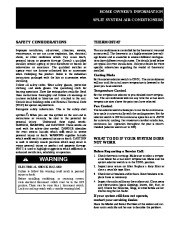| Categories | Carrier HVAC Manuals, HVAC Heating Ventilating Air Conditioning Manuals |
|---|---|
| Tags | Carrier PA13NR |
| Download File |
|
| Language | English |
| Product Brand | Support Phone Number: In North America, please call 1-800-CARRIER for immediate customer assistance from 8:00a -5:00p (EST) weekdays, Heating, Ventilating and Air Conditioning - HVAC |
| Document File Type | |
| Publisher | corp.carrier.com |
| Wikipedia's Page | Carrier Corporation |
| Copyright | Attribution Non-commercial |
HOME OWNER’S INFORMATION SPLIT SYSTEM AIR CONDITIONERS SAFETY CONSIDERATIONS Improper installation, adjustment, alteration, service, maintenance, or use can cause explosion, fire, electrical shock, or other conditions which may cause death, personal injury, or property damage. Consult a qualified installer, service agency, or your distributor or branch for information or assistance. The qualified installer or agency must use factory- authorized kits or accessories when modifying this product.
Refer to the individual instructions packaged with the kits or accessories when installing. Follow all safety codes. Wear safety glasses, protective clothing, and work gloves. Use quenching cloth for brazing operations. Have fire extinguisher available. Read these instructions thoroughly and follow all warnings or cautions included in literature and attached to the unit. Consult local building codes and National Electrical Code (NEC) for special requirements. Recognize safety information. This is the safety- alert symbol ! When you see this symbol on the unit and in instructions or manuals, be alert to the potential for personal injury. Understand these signal words: DANGER, WARNING, and CAUTION. These words are used with the safety- alert symbol. DANGER identifies the most serious hazards which will result in severe personal injury or death. WARNING signifies hazards which could result in personal injury or death. CAUTION is used to identify unsafe practices which may result in minor personal injury or product and property damage. NOTE is used to highlight suggestions which will result in enhanced installation, reliability, or operation. THERMOSTAT Your air conditioner is controlled by the thermostat mounted on your wall. The thermostat is a highly sensitive low voltage device and is available in several different configurations from different manufacturers. The details listed below are typical for most installations. Ask your dealer for more specific information regarding the model of thermostat installed. Cooling Mode Set the system selector switch to COOL. The air conditioner will run until the actual room temperature is lowered to the point you have selected. Temperature Control Set the temperature selector to your desired room temperature. The air conditioner will run any time the actual room temperature rises above the point you have selected. Fan Control The fan selector switch allows you to run the fan continuously or cycle it automatically with the cooling system. Set the selector switch to ON for continuous operation or to AUTO for automatic cycling. For maximum comfort satisfaction, continuous fan operation throughout the year is recommended (selector switch set to ON). WHAT TO DO IF YOUR SYSTEM DOES NOT WORK Before Requesting a Service Call: 1. Check thermostat settings. Make sure to select a temperature below the actual room temperature. Make sure the system selector switch is in the COOL position. 2. Inspect your return air filter. Replace a dirty filter or clean a reusable type filter. 3. Check circuit breakers and/or fuses. Reset breakers or replace fuses as necessary. 4. Inspect the coils and fins on the outdoor unit. Clean away any obstructions (grass clippings, leaves, dirt, dust, or lint). Check that branches, twigs, or other debris are not obstructing the fan blade. ! WARNING ELECTRICAL SHOCK HAZARD Failure to follow this warning could result in personal injury or death. Before installing, modifying, or servicing system, main electrical disconnect switch must be in the OFF position. There may be more than 1 disconnect switch. Lock out and tag switch with a suitable warning label.

